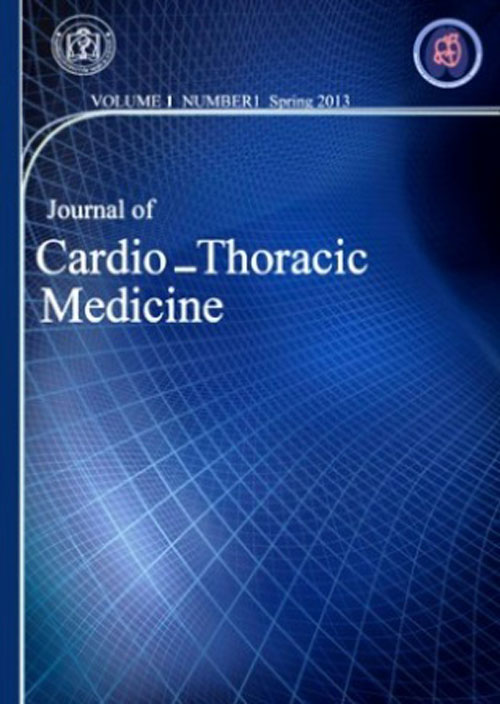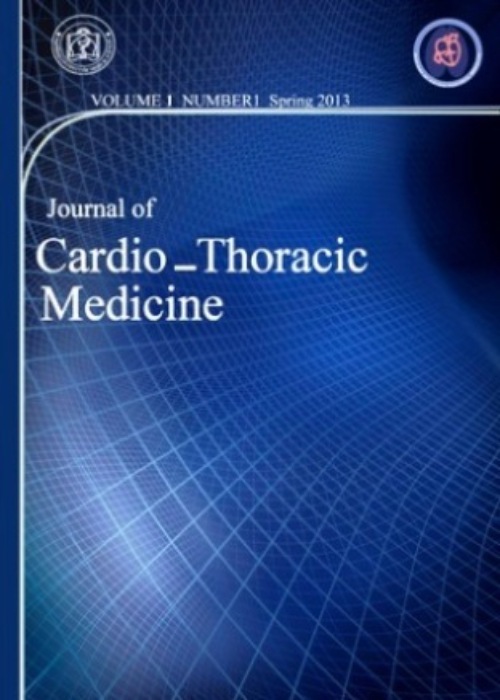فهرست مطالب

Journal of Cardio -Thoracic Medicine
Volume:10 Issue: 3, Summer 2022
- تاریخ انتشار: 1401/07/12
- تعداد عناوین: 8
-
-
Pages 1004-1009IntroductionEsophageal cancer (EC) is a common cancer of the digestive system which is one of the most common cancers in our country The primary treatment of EC is surgery. Due to the development of minimally invasive techniques (MIE), in the current study, we have assessed the results of these techniques in patients with EC surgery.MethodsA total of 80 patients with middle and lower third ECs who had good conditions and were operated with MIE technique (McKeown) from 2014 to 2021, were enrolled in this study. Patients were evaluated based on the following criteria: age, sex, tumor location, pathology, peri-operative complications leading the minimally invasive esophagectomy technique to being converted to an open surgery, and early post-operative complications after surgery and mortality.ResultsA total of 80 patients with EC were enrolled in the study. 85% (n=68) of our patients were male and 15% (n=12) were female with an average age of 58.21±11.39 years old. 43.75% of the patients had a history of neo-adjuvant chemotherapy. Surgery was performed with McKeown technique without complications in 91.25% of the patients. In 8.75% of the patients tracheal injury (n=1), uncontrolled bleeding (n=1), and severe pleural adhesions VATS (n=5) led the surgery plan changing into open surgery. Post-operative complications were observed in 13.75% of patients.ConclusionsThis study suggests using McKeown technique in patients with EC in highly experienced medical centers in order to obtain proper results with low rate of peri- and post-operative complications.Keywords: Esophageal Cancer, Minimally Invasive Esophagectomy, McKeown, Esophagectomy, Gastrointestinal Cancer
-
Pages 1010-1016IntroductionThe association between the serum antibody titer of several heat shock proteins (HSPs) and cardiovascular disease (CVD) risk factors so far has been the subject of several previous studies.AimTo evaluate the association of adiposity indices and HSP-27 antibody titers in healthy individuals.Materials and MethodsOverall 4823 individuals were recruited from Mashhad Stroke and Heart Atherosclerotic Disorders Study (MASHAD study), that included 1496 individuals with normal-weight (body mass index (BMI) <25 kg/m2), 1975 individuals with over-weight (BMI 25-30 kg/m2), and 1352 individuals with obesity (BMI≥ 30 kg/m2).ResultsThe serum anti-HSP-27 antibody titers were not significantly different among obese individuals [0.21 (0.11 – 0.34) absorbency unit (AU)], over-weight individuals [0.19 (0.10 – 0.33) AU] and normal-weight individuals [0.19 (0.10 – 0.33) AU].Conclusionswe have found no significant relationship among anti-HSP-27 antibody concentration and degrees of adiposity among Iranian adults.Keywords: Cardiovascular Disease, Heat shock proteins, Obesity
-
Pages 1017-1024IntroductionPleural effusion is a typical extrapulmonary cause of Tuberculosis (TB). The routine culture experiences an absence of affectability. Numerous markers in pleural fluid are assessed to analyze tubercular pleural fluid, yet no one is perfect. We have contemplated Adenosine deaminase (ADA), protein (CRP C - responsive) and Lymphocyte/Neutrophil (L/N) ratio in amalgamation for the determination of pleural effusion of tubercular origin.Material &MethodsAll patients presented with pleural effusion were put through thoracentesis and differentiated into transudative and exudative using Light's criteria. Patients with exudative pleural effusion aetiology were further bisected into two groups with a sample size of 30 patients. Group I consisted of patients with tubercular cause, and Group II comprised other than tubercular. ADA, CRP and L/N ratio of these subjects were estimated in pleural fluid. The sensitivity, specificity and predictive values were calculated.ResultsThe ADA, CRP, and L/N ratio's sensitivity, specificity, positive predictive value, and negative predictive value were, respectively, 83.3%, 90.0%, 89.29%, 84.37%, 76.67%, 90.0%, 88.46%, 79.41%, 96.67%, 43.33%, 63.04%, and 92.86%. The conjunction of ADA and CRP exhibited the highest specificity for pleural effusion caused by Tuberculosis; however, both ADA and CRP showed comparable specificity on their own.ConclusionsDiagnosing tubercular from non-tubercular individuals was made easier with the help of Pleural fluid ADA and CRP. Combining ADA, CRP, and L/N ratio does not offer any significant advantages beyond just combining ADA and CRP.Keywords: Pleural Effusion, Adenosine deaminase, C- reactive protein
-
Pages 1025-1031IntroductionAortic valve replacement with either mechanical or bioprosthetic valves is the gold standard treatment for severe aortic stenosis. Unfortunately, enhanced bleeding and hemodynamic decompensation thrombocytopenia is a frequent postoperative complication. The latter could be secondary to the shearing effect of mechanical prosthesis upon the blood flow that favors platelet aggregation or the presence of thrombogenic materials such as glutaraldehyde used to preserve bioprosthetic valves. Our aim was to discern which type of valve is associated with a more severe post-surgery thrombocytopenia so we compared postoperative platelet counts in patients treated with mechanical vs bioprosthetic valves.Material and MethodTwo hundred and fifty patients with severe aortic stenosis underwent valve replacement surgery were included in the analysis. 126 patients received a mechanical (group A) and 124 patients received a biological (group B) prosthesis. A conventional surgical procedure with Extracorporeal Life Supports (ECLS) was performed in all. Patients’ age, gender, cardiovascular risk factors, type and time length of antiaggregant treatment, size of the implanted valve, and perioperative events were recorded. Pre-surgery platelet count and daily post-surgery registers of platelets count for a 10-day period was documented.ResultsPlatelet count before surgery was within normal values in both groups. There was a significant decrease the first postsurgical day in both groups (127±48 vs 224±56 in group A, and 132±45 vs 229±54 in group B, p <0.001). Normal platelet count, was reached the fourth post-surgery day in group A patients compared to the eighth day of group B. The differences in platelet count between both groups, independently of the postsurgical day, were highly significant. Thrombocytopenia remained significantly lower and did not reach normal values (141) in the 10 days follow-up in patients that received the 19 mm prosthesis, whereas those receiving the 21 mm valves reached normal values (150) the eighth day.ConclusionThrombocytopenia in patients undergoing aortic valve replacement is secondary to the synergic effect of ECLS, aldehydes present on the preservation solution of prosthesis, and the shear flow induced by the prosthesis diameter. The implant of small diameter prosthesis prolongs thrombocytopenia.Keywords: Aortic stenosis, biological valves, mechanical valves, Postoperative, Thrombocytopenia
-
Pages 1032-1038
Spontaneous pneumothorax is one of the rare complications associated with COVID-19 viral pneumonia, and its exact mechanisms are still unknown. Most often this complication occurs in the setting of mechanical ventilation. This case series reports seven patients with the first presentations of spontaneous pneumothoraxes developing in the absence of mechanical ventilation.This case series study presents seven cases of COVID-19 with a positive COVID-19 PCR test result. A few days had passed from the onset of symptoms, and they had severe pulmonary involvement and high inflammatory markers. The patients received treatment for COVID-19; however, they developed hydropneumothorax and subcutaneous emphysema before being hospitalized or on the first day of hospitalization. A ventilator was used in the case of some patients. The mortality rate was high among these patients.These cases confirm the hypothesis that unusual manifestations of COVID-19 can lead to life-threatening conditions. Therefore, the diagnosis and treatment of these special COVID-19 cases are highly important.
Keywords: case report, COVID-19, Pneumomediastinum, Pneumothorax, Subcutaneous Emphysema -
Pages 1039-1043
Pulmonary alveolar microlithiasis (PAM) is a rare inherited pulmonary disease characterized by the deposition of intra-alveolar calcium deposits. In most of the Asian and European countries, PAM is usually misdiagnosed as pulmonary tuberculosis and sarcoidosis. We presented a young case of PAM manifested as chronic progressive dyspnea unresponsive to corticosteroids for one year. The first diagnostic clues were made by high resolution computed tomography. Although Bronchoalveolar lavage and transbronchial lung biopsy examination were unremarkable, however, after performing a Video-assisted thoracoscopic surgery, the biopsy specimens confirmed the diagnosis of PAM.
Keywords: Assisted Thoracoscopic Surgery, Bronchoalveolar Lavage, Pulmonary alveolar microlithiasis, PAM -
Pages 1044-1047
Primary thyroid lymphoma (PTL) is a rare neoplasm that requires early and accurate diagnosis, as its approach and management is different from other thyroid malignancies. Primary thyroid lymphoma (PTL) usually presents with rapidly growing neck mass with pressure symptoms. We report two elderly females with PTL who developed a painless enlarging thyroid mass. They had no medical history or family history of thyroid disease. Based on clinical symptoms and radiologic findings, both of them underwent surgical resection of the tumors. Ultrasonography and CT scan showed no specific findings, and like Hashimoto's thyroiditis, only a large diffuse thyroid with nodular tissue was found. Postoperative histologic examination revealed high-grade non-Hodgkin lymphoma. Overall, these cases emphasize the importance of considering Primary thyroid lymphoma (PTL) when dealing with large thyroid tumors. Although the treatment of choice for Primary thyroid lymphoma (PTL) is chemoradiotherapy, surgery could be performed when the diagnosis is inconclusive or has compressive symptoms.
Keywords: Primary Thyroid Lymphoma, Non-hodgkin’s lymphoma, Thyroid -
Pages 1048-1051
About 1% of Thoracic Outlet Syndrome (TOS) cases are arterial. It is due to compression of the subclavian artery over the first rib. This case report describes a left subclavian artery compressed by the left anterior scalene muscle. The patient was a 20 years old male complaining of coldness and cyanosis of the left hand upon standing in a military position. We performed the left thoracic outlet decompression from the supraclavicular incision. We preserved it. We resected the left anterior scalene muscle and released the left subclavian artery and then closed the layers in anatomic position. The next day we visited the patient He expressed complete recovery from previous symptoms. His left hand was warm and there was no decrease in radial upon left arm abduction. The supraclavicular approach is a safe and effective approach to treating arterial TOS. It results in good functional outcomes in most patients, and it doesn’t have serious complications. This method can be used as the approach of choice in patients selected properly.
Keywords: Subclavian, scalene muscle, Artery


